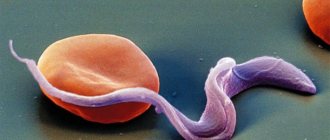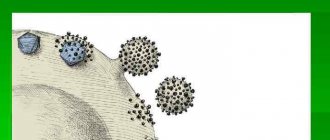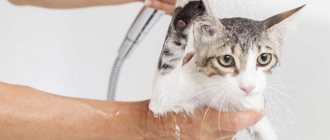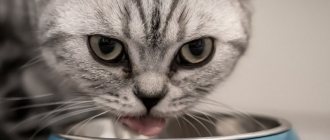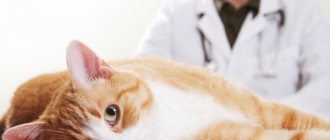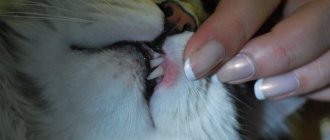Inflammatory processes in the joints, accompanied by a functional disorder of the musculoskeletal system in domestic cats, are not uncommon. Older pets are more susceptible to the disease. In young animals, the main cause of arthritis is injury.
The variety of forms of the disease, as well as nonspecific symptoms, including in later stages, make early diagnosis difficult. Treatment includes not only medication, but also a therapeutic diet and physical therapy.
Read in this article
Causes of arthritis
According to veterinary orthopedic specialists, the following reasons lead to inflammation of the joints:
- Advanced age of the pet . The passing years lead to a decrease in the elasticity of connective tissue, deterioration of the trophism of the organ, which leads to arthritis in an elderly animal.
Osteoarthritis in aging cats primarily affects the shoulder and elbow joints. After 12 years, the disease occurs in 90% of individuals.
- Genetic predisposition . Some breeds that have appeared as a result of artificial selection recently have been susceptible to inflammatory processes of the musculoskeletal system.
Most often, fold-eared cats, such as the Scottish Fold, suffer from this disease. The defective gene is associated with a phenomenon called hip dysplasia. Congenital anomalies in the structure of connective cartilaginous tissue are also common in such breeds.
- Injuries . Falls from heights, collisions with vehicles, fights with relatives and the original feline enemies - dogs, are usually accompanied by bruises, dislocations, and sprains. Damage to the tissues of the musculoskeletal system as a result of trauma leads to inflammatory processes and the development of traumatic arthritis.
This category also includes birth trauma, which causes deformation of the hip joint and resulting inflammation.
- Obesity . Extra pounds on a furry pet puts additional stress on the joints, increases friction in the organ, and reduces the amount of intra-articular fluid, which provokes an inflammatory process.
- Autoimmune diseases are the most common cause of so-called rheumatoid arthritis in pets. The pathology is due to the fact that for some reason the cat’s body synthesizes substances that destroy its own cartilage tissue. The disease is generalized, affecting almost all joints.
- Acromegaly can lead to arthritis in domestic cats . The pathology is associated with increased synthesis of growth hormone, which leads to degenerative processes in cartilage tissue.
- Metabolic disorders . This category of causes causes the development of so-called metabolic arthritis. A deficiency of calcium, phosphorus, and an incorrect ratio of these elements causes disruption of the structure of cartilage and bone tissue, leading to the development of multiple inflammatory lesions of the joints.
A pathology such as heterochromatosis, in which iron accumulates in the elements of the musculoskeletal system, also contributes to the development of polyarthritis in domestic animals.
- Infectious processes in the body of various etiologies: viral, bacterial, fungal. Pathogenic microorganisms become the main factor in the development of the purulent form of the disease. The cause of polyarthritis is often viral influenza, calcivirus, and hepatitis virus in cats.
Veterinary specialists, based on many years of practice, believe that inflammation of the joints in furry pets can be provoked by an unbalanced diet, weakened immunity, increased physical activity, and exposure to cold.
Drug treatment
In most cases, treatment of joint diseases in cats involves the use of non-steroidal anti-inflammatory drugs (NSAIDs), which not only stop the inflammatory response, but also significantly reduce the intensity of pain. The main disadvantage of drugs of this type is the impossibility of their long-term use (in this case, the liver and kidneys suffer greatly). To minimize the risk of side effects, the drug must be selected carefully and used with caution.
Injuries often lead to the development of the disease. These could be injuries received at the birth of a kitten, or acquired as a result of falls, fights, or road accidents. Any bruises or sprains can lead to inflammation.
Arthritis can be caused by excess weight in a cat. With obesity, an increased load is placed on the animal's joints. Often they may not be able to cope with it, especially if the pet is active. And in the presence of metabolic disorders, which often accompany weight problems, the situation gets worse. The structure of cartilage tissue and joints changes, and there is a lack of essential vitamins and microelements. As a result, an inflammatory process develops.
Autoimmune diseases lead to the development of rheumatoid arthritis. The animal's body perceives its own cells as foreign. It begins to “defend itself” by producing substances that destroy cartilage tissue. As a result, arthritis develops, which affects all joints.
Another disease that leads to joint inflammation is acromegaly. Older cats are susceptible to it. The animal’s body begins to produce a huge amount of growth hormones, and diabetes develops, which leads to joint damage.
Arthritis can result from a bacterial infection in a cat. Bacteria enter the joint capsule from an open wound or when infected with an infectious disease. In this case, it is possible not just inflammation, but the formation of purulent arthritis, which can be life-threatening for the animal.
Symptoms in cats
Irreversible functional disorders in the joint begin with the destruction of cartilage and bone tissue. Degenerative processes lead to wear and tear of the elements of the musculoskeletal system, a decrease in intra-articular fluid and the development of inflammation.
The structure of a healthy joint and arthritis
At first, pathological changes do not cause pain to the animal, and the disease does not have pronounced symptoms. Stiffness of movement, severe pain, and changes in the general condition of the pet do not develop immediately. In this case, the owner may note the following clinical signs in a domestic cat:
- Decreased physical activity. The pet avoids jumping, reluctantly takes part in active games, and does not hunt mice and birds.
- Lethargy, apathy, fatigue. The cat spends most of its time sleeping or half asleep.
- After resting or sleeping, the animal has difficulty getting up and moving. Movements are constrained, gait is cautious. After some time, the gait becomes normal.
- The cat stops using the scratching post and avoids going up the stairs.
- Reduces grooming and is reluctant to lick. After visiting the litter box, he does not bury feces. This behavior is associated with joint pain.
- A previously friendly animal becomes aggressive when touched. The cat does not allow itself to be controlled, is nervous and worried.
- When you feel the joints, swelling, pain, and thickening are detected. In some cases, thinning of the limbs is observed.
- The bone joints are hot to the touch.
- The animal has an increase in body temperature, poor appetite or refusal to feed.
Many owners of sick animals note that with an inflammatory disease of the musculoskeletal system, the pet tries to avoid communication with household members and seeks solitude.
For information on the causes and symptoms of joint diseases in cats, watch this video:
Arthritis symptoms
The symptoms of arthritis in cats are poorly detected in the early stages; in order to see health problems, you need to carefully monitor your pet. If you notice similar signs in behavior with symptoms of arthritis, you should not rush to conclusions. It is advisable to contact a veterinarian and conduct a thorough diagnosis if the following signs are detected in the animal’s behavior:
- Caution in behavior - the cat walks slowly or carefully, overcomes obstacles with difficulty, jumps, runs or plays less, avoids high climbs, mostly stays on the floor.
- Lack of play activity - plays lying down or is not active enough, does not show interest in toys.
- She walks past the tray - due to the high side, it is inconvenient for her to relieve herself in the tray if there is pain in the joints or difficulties in movement. It can also indicate to owners problems with their health.
- Apathy and lethargy - avoids communication and games with other animals or owners.
- Decreased appetite - eats little or rarely, does not ask for treats.
- Lack of grooming - due to pain and difficulty in bending the joints, grooms the coat less often or does it with difficulty.
Apathy and lethargy in a cat are one of the symptoms of the disease.
Additionally, you can look for excess weight due to decreased activity, but some cats lose weight when they stop eating. When moving, you can hear a crunch or notice that her paws periodically cramp. In this case, she will walk along a curved path, trying not to step on the sore paw or shake it, experiencing discomfort. As a result of inflammation, body temperature may increase.
Diagnosis of the disease
Uncharacteristic symptoms and similarity with numerous other pathologies of the musculoskeletal system make early diagnosis of the disease difficult. An experienced veterinarian will pay attention first of all to the unkempt coat and plantigrade position of the hind limbs.
Classification of arthritis
An orthopedic examination involves a specialist observing the animal in motion. However, in a clinical setting it is not always possible to obtain a reliable picture due to the inappropriate behavior of a furry pet in an unfamiliar environment. Video recording methods that can be used by owners of a sick animal come to the rescue.
After the gait has been studied, the veterinarian begins to palpate the joints to detect swelling, pain, and changes in the anatomical configuration.
Special research methods, for example, radiography, can help in identifying inflammatory processes. On it, an experienced orthopedic doctor will detect anomalies indicating degenerative-dystrophic changes in the organ, osteophytosis (bone growths), swelling of soft tissues due to inflammation.
X-ray (lateral view) of the elbow joint of a cat with osteoarthritis
An informative method in the diagnosis of arthritis is the study of synovial fluid to detect pathogenic microflora and select an effective antibacterial agent.
As additional diagnostic methods, high-tech examination of the condition of joints using magnetic resonance and computed tomography can be used.
Clinical and biochemical tests of blood and urine are prescribed by a veterinary specialist, as a rule, for the purpose of differentiated diagnosis and identification of concomitant pathologies.
Treatment methods
Polyarthritis in domestic cats is a chronic process with severe pain that has to be managed over a long period of time. In this regard, orthopedic veterinarians try to choose not only effective medications, but also drugs that have minimal toxic effects on the animal’s body.
On the list of medications prescribed to domestic cats for arthritis, non-steroidal anti-inflammatory drugs take first place. Prostaglandins block the breakdown of arachidonic acid, which is involved in the inflammatory process.
For long-term treatment of pathologies of the musculoskeletal system, drugs such as Meloxicam and Piroxicam have found wide use in veterinary practice. Both nonsteroidal anti-inflammatory drugs are used once daily. The dose and duration of the course are determined by the attending veterinarian.
NSAIDs in the treatment of arthritis
When the process worsens, painkillers such as Buprenorphine, Amantadine, Fentanyl, Tramadol, Gabapentin can be used to relieve pain. The difficulty with using opioid medications is that many pain medications are controlled drugs.
Long-term use of glucocorticosteroids in the form of Prednisolone and Dexamethasone does not bring a therapeutic effect and is associated with a number of undesirable side effects.
In addition to drug treatment, modern veterinary medicine recommends that owners of sick animals pay attention to physiotherapy: reflexology (acupuncture), manual massage, electrical myostimulation, laser use, hydrotherapy (swimming in the pool).
Care, maintenance and nutrition of a sick animal
The owner can alleviate the condition of a cat with arthritis not only by using medications prescribed by a veterinarian, but also by following certain rules for care and feeding.
First of all, you need to take care of the safe living of your pet indoors. If your cat likes to sleep in an elevated place, on a windowsill, or a closet shelf, you should equip this place with a warm lounger and take care of a safe descent. For this purpose, you need to install a chair or ladder so that the animal avoids jumping.
The best solution would be to purchase or make your own cozy house with a warm and soft lounger. Such a sleeping place will allow a sick pet to rest in a safe, dark place. It is necessary to completely exclude the cat from being on cold concrete floors, tiles, in drafts and in damp rooms.
Doors in the house should be secured in the open position. This will make it easier for the cat to walk. You also need to pay attention to the shape of the cat litter box. The tray on one side should have a lower side so that it is not difficult for the cat to enter it.
The owner of a sick pet should pay great attention to hygiene procedures. The animal needs regular help with grooming and trimming its nails.
The complex of measures for caring for a cat suffering from arthritis includes proper feeding. First of all, the owner must take measures to prevent obesity. If the animal is already overweight, the attending physician should recommend a diet to reduce it.
In order to reduce inflammatory processes in the musculoskeletal system, various biological additives are used in veterinary practice, for example, omega-3 fatty acids, glucosamine, chondroitin . These substances are involved in the synthesis of cartilage tissue, which helps improve the condition of the joints.
Some cat food manufacturers produce special medicinal series that include substances that are beneficial for an arthritic cat, for example, Hill's PD J/D, Pro Plan Veterinary Diets Feline. The food contains a number of biologically active substances, for example, eicosapentaenoic acid, omega-3 fatty acids, glucosamine and chondroitin, which reduce pain, degenerative and inflammatory processes in cartilage tissue.
A cat with arthritis is strictly contraindicated from table food, fatty, canned, salty and sweet foods. Preference should be given to lean meat, raw and boiled vegetables, water-based cereals, and dairy products.
Arthritis in domestic cats is a common chronic disease. The disease has no characteristic symptoms and is difficult to diagnose in the early stages of the process. Treatment is complex and includes not only long-term use of anti-inflammatory drugs, but also physiotherapy. The effectiveness of therapy largely depends on proper care and feeding of the sick pet.
Patient care
Creating the right conditions to improve your cat’s quality of life involves selecting a tray with a low side and a large size. Elimination of drafts in the pet’s area of residence, prohibition of high lifts. Selecting a soft bed at a low level from the floor, choosing a warm place for a house or bed, assistance in grooming and trimming nails.
Creating good conditions for your cat as a way to prevent arthritis
It is not recommended for a cat to spend a lot of time outside, especially in the cold season, or lie on the ground or concrete if it lives in a private house. The pet's sleeping place can be heated, this will help relieve pain
Places of ascents and descents must be protected from sudden and high jumps by the presence of additional stools.
The cat's frequented areas should be warm and dry.
Useful video
To learn how to treat arthritis, watch this video:
Source zootvet.ru
Arthritis is a group of inflammatory joint diseases accompanied by severe pain. Inflammation usually spreads to the joint capsule, cartilage and synovial membranes of the inner surface of the joints. In complicated cases, other elements of the joint and adjacent tissues may be involved.
Arthritis in cats is rare, and in the early stages its signs are almost invisible. This complicates the diagnosis and differentiation of the disease from other ailments with similar symptoms. This article will tell you how this disease progresses, whether it has features and complications, characteristic symptoms and methods of treatment.
Description of the disease
It is difficult for an inexperienced owner of a furry pet to notice the manifestations of the disease. Cats quickly adapt to mutations in their bodies and change behavioral habits.
Table 2. Symptoms of arthritis
Arthrosis is a chronic disease that affects cartilage and leads to changes in the cat's skeleton. The joint, in general, connects two bones, the heads of which are covered with cartilage.
The latter protects the skeleton from friction. The cartilage is covered on top with a special “bag” - an articular sheath. A special liquid promotes sliding.
Elasticity decreases. Over time, this leads to the death of collagen fibers. The joint is wetted less and less by the liquid, gradually dries out, becomes smaller and, ultimately, collapses. Accordingly, the load on the skeleton increases. The cat's joints are literally cracking.
But it is not all that bad. This is just the first stage. With timely diagnosis, joint problems in cats can be cured. This is facilitated by modern medications and massage, as well as a high-quality rehabilitation period at home.
If this does not happen, then the growths on the cartilage increase, grow and the bone gradually becomes deformed. She cannot cope with the loads and the so-called “hock” joint is damaged. The cat is in severe pain and is constantly limping.
In extreme cases, the pet completely loses mobility, and this process is no longer reversible and the animal, in most cases, will have to be euthanized.
The most dangerous thing about joint problems is that common symptoms have never been identified, although the disease is quite common among cats. The disease affects animals in advanced stages, when they are inactive, sleep a lot and do not show dissatisfaction. This fact significantly complicates the diagnosis of pathology.
Despite the similar symptoms, arthritis and arthrosis are different diseases. The first is characterized by inflammation throughout the body. The latter is localized only in the joints. Consequently, therapy and medications for arthritis will be slightly different. By the way, osteoarthritis is, for the most part, a synonym for the disease in question.
With arthrosis, a cat experiences severe pain and has difficulty moving.
Arthrosis has distinct symptoms:
- Pain. The main sign of the disease. In the early stages it manifests itself with increased physical activity and active movement. A sick animal will limp a little after jumping even from a small height; protect its paw from stress when playing and walking. At the second stage, the animal experiences pain when moving short distances, but after a short rest it feels relief. The third stage is characterized by systematic limping, the animal tries to move less. Very often, a cat can change its usual sleeping position. If arthrosis develops in an animal in old age, then when the weather changes, it, like a person, will feel discomfort in the joints.
- Limited movement. It worsens in the second stage of the disease.
- Crunch. When moving, the joints crunch loudly and dryly.
- Deformation. It is considered the “final” symptom of arthrosis, since it manifests itself already when the disease is advanced. The contour of the joint changes - it becomes rounded, irregularities appear on it, and an unnatural position is noticed.
Note! Arthrosis has a negative effect on a cat's fur. Due to the pain, the animal cannot pay proper attention to it, so the cover becomes dull, becomes very dirty and becomes tangled.
Predisposition to arthritis
Animals of any age, including young animals, are susceptible to the disease, but it is more often diagnosed in older cats with worn-out joints. Degenerative processes in the body are an important trigger for arthritis.
In young individuals, arthritis is most often caused by injuries and hereditary diseases (hip dysplasia). The percentage of cases of arthritis in females and males is approximately the same.
There is also some breed predisposition. It is believed that cats of the Scottish Fold, Maine Coon and all artificially bred breeds are at risk.
What types of polyarthritis are there?
They are divided into several varieties, each of which has different manifestations and dangers to the pet’s health:
- Arthritis of traumatic etiology. Perhaps one of the most common varieties. Prerequisites – strong impacts, . Traumatic arthritis develops more often in service dogs.
- Functional type arthritis. Depends on the type of use of the animal. As in the previous case, this polyarthritis most often occurs in dogs. Thus, those used by rescuers carry many kilograms of cargo on their backs (food and water for people who can be found by a dog under the rubble). Because of this, their joints are often overloaded for a long time, which causes their accelerated wear.
Arthritis in cats is a disease that has received little attention for many years. In addition to the fact that the pathology is difficult to diagnose, the existing choice of methods to combat the disease is limited. However, over the past decade, veterinary medicine has made significant progress in its study. The treatment experience accumulated by specialists, the causes and symptoms of treatment of the disease are discussed in this article.
Arthritis in cats: symptoms and treatment
According to medical terminology, the pathology is called osteoarthritis. This concept refers to a chronic joint disease that causes deformation of the limbs.
The disease is accompanied by the following deviations:
- cartilage degeneration;
- mutation of the shell of the joint capsule;
- overgrowth of bone tissue in the joint area.
Table 1. Causes of arthritis
| Causes | Description |
| Injuries | Unsuccessful landings, domestic injuries, and jumping from heights can result in damage to the limbs. If the animal is not treated promptly, arthritis may develop. |
| Bad heredity | About 70% of animals are genetically predisposed to this pathology. Artificially bred breeds are at risk |
| Metabolic disorder | Excessive obesity that occurs during this process is dangerous to the health of cats. Excess weight puts unwanted stress on the musculoskeletal system. In addition, a failure in metabolism is fraught with the appearance of negative changes in the structure of cartilage tissue. It gradually thins and collapses |
| The influence of pathogenic microorganisms | Penetrating into the joint capsule, pathogens infect tissues. Some pathogenic bacteria settle on the cartilage and cause an inflammatory process. If the microorganisms are of pyogenic origin, purulent arthritis begins, leading to death after blood poisoning |
| Exposure to cold | If a cat spends a lot of time on a cold floor or is in a draft, rheumatoid arthritis gradually develops. |
| Age factor | Over time, joints wear out. In particularly active individuals, they are erased from the inside and become excessively fragile. |
Most often the disease attacks the following joints:
- elbow;
- hock;
- knee;
- humeroscapular;
- hip.
The defeat occurs simultaneously on both sides.
Osteoarthritis is considered an age-related disease. Since cats do not have the inherent immunity of their wild relatives, joint inflammation is common in pets.
Depending on the duration and clinical picture of the disease, subacute, acute and chronic forms of the disease are distinguished.
According to statistics, arthritis is observed in 90% of cases in older cats. It occurs much less frequently in young pets, mainly after joint injury or due to a genetic predisposition.
There is no relationship between the sex of the animal and the occurrence of pathology. Excess weight and hip dysplasia, which is common in breeds such as the Maine Coon, for example, can trigger the disease.
Types of disease and its causes
Arthritis has several varieties, depending on the nature of the damage to the joint and the causes that cause it. Based on the nature of the lesion, two groups of arthritis are distinguished:
Inflammatory arthritis
Inflammatory arthritis is based on inflammation of the synovial membrane (the inner lining of the joint surface). There are several varieties depending on the reasons:
- Rheumatoid arthritis is the most common. First of all, connective tissues are always affected. It is necessary to carefully examine the cat in order to establish the cause of the disease and choose the right treatment. It is assumed that the causes are hereditary autoimmune disorders and severe viral infections (mycoplasmosis, herpes, retroviral infections).
- Infectious arthritis is an inflammation of the joints that is bacterial, viral, fungal or parasitic. The infection can enter the joint from the outside, or it can enter along with the bloodstream. The disease is usually accompanied by a general reaction of the body: fever, intoxication, severe pain.
- Reactive arthritis is a secondary joint disorder that develops after a primary infection affecting the gastrointestinal tract, genitourinary or respiratory system. It is believed that its cause is a non-standard immune response of the body to the introduction of infection. Reactive arthritis is usually an uncomplicated inflammation without a purulent component.
- Metabolic arthritis is caused by metabolic disorders, which are caused by poor diet. These are calcium-phosphorus deficiency, heterochromatosis and some other abnormalities.
Degenerative arthritis
Degenerative arthritis develops as a result of damage to the surface of the articular cartilage. Their list looks like this:
- Traumatic arthritis is inflammation of a joint caused by injury. This can be sprained ligaments, bruises and other closed injuries, causing hemorrhage into the joint capsule and aseptic inflammation.
- Osteoarthritis occurs in older adults and affects worn-out joints. The process involves joint bones and cartilage tissue. Overgrown bone tissue injures the joint, which loses its mobility and elasticity. A characteristic symptom of this form of arthritis is crepitus (crunching) of the joint when moving.
- Functional arthritis is a type of traumatic arthritis. It occurs as a result of injury from a strong blow with the paws. When a cat falls from a height onto its paws, the destructive load falls on the knees, causing dysfunction of the knee joint. The long-term consequence is functional arthritis.
Types of arthritis
The joint consists of a cartilaginous surface of the bone, a capsule, and an articular cavity filled with synovial fluid. Inflammatory processes occur in the inner part of the surface of the articular cartilage (synovial membrane). Their varieties depend on the causes of the pathology and have the following characteristic features:
- Rheumatoid is the result of autoimmune processes, which consists in the development of antibodies that can attack their own cells and not recognize harmful bodies. This causes disruption of motor processes due to infections and viruses (herpes, mycoplasma).
- Infectious - the result of inflammation due to the introduction of a special protein of bacterial or fungal microflora. Parasites or viruses enter the blood and then into the joint, causing side effects of the body: intoxication, fever, increased body temperature, acute pain.
The entry of a foreign protein into the blood can occur through the bite of insects, mammals (mice, rats), through scratches and bruises of a cat. To avoid this, it is necessary to vaccinate the animal every year so that its immunity can recognize viral bodies and easily fight them when infected.
- Reactive inflammation is subsequent inflammation of the joint against the background of general intoxication due to infectious lesions of other body systems (digestive, reproductive, genitourinary, respiratory).
- Metabolic in nature - associated with metabolic disorders due to unbalanced nutrition (lack of calcium and phosphorus) of the pet.
Therapeutic examination of a cat with symptoms of arthritis
Types of arthritis depending on the degree of damage to the joint surface:
- Traumatic - physical injuries that cause bruises, sprains, hematomas, which allow blood to enter the joint capsule. This type of arthritis is visually noticeable due to functional difficulties in movement and requires immediate treatment or surgical intervention.
- Osteoarthritis - the cartilage structures and bones of the joint involved in the destruction process wear out with age. The bone tissue grows and injures the joint. The animal's movements are accompanied by a crunching sound.
Forms of the disease
According to the duration and severity of the course, acute, subacute or chronic forms of the disease are distinguished.
In acute cases, inflammation is accompanied by the formation of serous exudate. The process can be complicated by the loss of fibrinous sediment or purulent inflammation spreading to adjacent tissues and muscles.
Chronic arthritis, occurring for quite a long time with periodic relapses, leads to the growth of the lining of the inner surface of the joints and granulation of the cartilaginous surface. This is fraught with the development of deformities and contractures of the joints.
Provoking factors
There are quite a large number of factors, the presence of which provokes and significantly accelerates the onset of the disease. Here are the main ones:
- Burdened heredity. It is believed that more than 70% of the total number of animals are predisposed to arthritis precisely for this reason.
- Excess weight and obesity are a very big risk factor for animals. An obese cat is automatically considered susceptible to arthritis and should undergo periodic orthopedic examination.
- Metabolic disorders cause thinning of cartilage, and therefore create a high risk of developing metabolic arthritis.
- Instability of the joints in a cat, which occurs as a consequence of injuries and traumatic effects (falls from a height, other extreme loads on the joints).
- Infectious diseases can cause complications in the form of infectious arthritis. There is a possibility of pathogenic bacteria penetrating directly into the joint through damaged skin.
- Hypothermia weakens the immune system and can provoke the development of severe inflammation.
- Degenerative processes and wear and tear of joints in old age make all cats over 5 years of age susceptible to arthritis and arthrosis.
- Acromegaly, or increased synthesis of growth hormone, is an autoimmune disease that causes arthritis.
Causes of the disease
Veterinarians identify many factors that provoke the development of the disease, but the most common include:
- Changes in the body associated with the age of the animal (occurs in more than 65% of cases).
- Intense physical activity, due to which the animal is often injured.
- Joint infarction. Occurs when there is a powerful overload or injury to an organ (a fall from a great height, a strong blow, etc.).
- Developmental pathologies. Diagnosed as congenital joint dysplasia.
- Genetic predisposition. In cats with a history of arthrosis in their family, the likelihood of developing the disease increases by 35 percent.
- Previous and untreated inflammation of the joints.
- Ailments caused by abnormal metabolic processes, for example, calcification or gout.
- Obesity increases stress on joints and makes them less resistant to external injury.
Important! Most often, joint dysplasia occurs in Maine Coons and representatives of Scottish, Abyssinian and Persian breeds.
Symptoms of the disease
In diagnosing arthritis, the owner's observation plays a major role. Therefore, every owner should know what symptoms may indicate that their pet is sick. Some features of the animal’s behavior should alert the attentive owner:
- the cat has difficulty going up and down stairs, avoids jumping on the bed, sleeps more on the floor, does not use a scratching post;
- there is a clear decrease in playfulness;
- defecates not in the tray, but next to it;
- became lethargic, avoids communication with people and other animals, stopped purring;
- appetite is significantly reduced;
- cares for the coat less carefully, neglecting those areas that are difficult for her to reach due to pain;
- protects joints, meows or hisses when stroking them;
- there is a stiff or stilted gait, lameness;
- weight loss may occur.
The owner should take into account some physiological features, which are also signs of arthritis:
- The cat’s claws are too long because she doesn’t grind them down;
- increase in size, crepitus of diseased joints;
- increase in local temperature in the area of inflammation.
Diagnosis of the disease
The veterinarian makes a diagnosis based on the owner’s story about the animal’s unusual behavior. It is difficult to conduct an orthopedic examination of a cat in a clinical setting because it is stressed and constrained. Subsequently, the joints are palpated. It makes it possible to determine their condition and degree of deformation. If arthritis is suspected, several more diagnostic procedures are prescribed to help clarify the picture of the disease:
- X-rays are prescribed to identify bone growths, thickening of soft tissues, and narrowing of the joint space;
- bacteriological examination of synovial fluid is carried out if infectious arthritis is suspected;
- A biochemical analysis of blood and urine is prescribed to exclude concomitant diseases.
Treatment of the disease
Treatment of arthritis in sick cats should be comprehensive and include several areas. The main goal is to stabilize the condition and improve the quality of life of patients. The disease, unfortunately, has no cure, but with good supportive therapy and proper care, remissions will be quite long, and motor activity will be restored almost completely. The following types of therapy are used:
- surgical intervention;
- drug therapy;
- special care;
- rehabilitation measures to maintain a stable condition of the joints;
- therapeutic nutrition and weight correction;
- physiotherapy.
Surgery
It is justified as an emergency measure in the later stages of the disease, in the presence of severe concomitant diseases (joint instability, severe joint dysplasia). In these cases, it is not possible to alleviate the animal’s condition in any way, relieve severe pain and improve the quality of life using conservative methods.
Special care
It consists of creating comfortable living conditions that make life easier and reduce joint pain:
- first of all, this is the creation of a warm, safe place to sleep, away from drafts;
- to make jumping easier, intermediate supports are placed under the elevations;
- purchase litter trays with a low side;
- place inclined surfaces where there are steps;
- comb the fur and trim the claws to make grooming easier for the cat.
Drug therapy and pain relief
Drug therapy consists of prescribing non-steroidal anti-inflammatory drugs. They have significant side effects, so before starting treatment, they determine whether there are severe pathologies of the kidneys and gastrointestinal tract. Usually the minimum effective dose of drugs is used. Meloxicam is the most suitable drug for cats. The course of its administration can be unlimited in time.
Glucocorticosteroids are not used in the treatment of arthritis, since their systemic side effects may exceed the effect.
Assistive therapy and rehabilitation
As an adjuvant therapy, it is common to use supplements based on chondroitin and glucosamine. They help restore worn cartilage, slowing down its destruction.
In addition, cold and warm compresses can be used on the sore joint:
- a cold compress is used in the acute phase with severe inflammation;
- a warm compress is applied after the inflammation is relieved to stabilize the condition.
In case of purulent inflammation, the use of warm compresses is strictly prohibited.
Medical nutrition
There are specialized foods for cats diagnosed with this disease. They are a therapeutic diet with a high content of omega-3 fatty acids, chondroitin and glucosamine, which restore articular cartilage. Such foods have a limited fat content, which allows you to adjust the animal’s weight, avoiding obesity.
A sick cat is strictly contraindicated from table food that includes too fatty foods with an unlimited amount of salt and seasonings. Natural nutrition should consist of lean meat, dairy products, and a small amount of fish.
Physiotherapeutic treatment
Among the methods of physiotherapy for cats, massage procedures are recommended. The massage should be very light, but persistent, making blood circulation more active. It is necessary to carry out circular massage movements, slowly moving along the limb to the sore joint.
In some cases, acupuncture may be used. It helps relieve spasms and relieve pain. Should only be carried out by competent specialists with experience in using this method in veterinary medicine. The downside is that it can only be used if the animal is at rest. It seems possible to do this only under the influence of sedatives or anesthesia.
Care
A sick animal needs privacy. The optimal solution is to arrange a cat house with soft bedding. Do not allow your pet to remain on a concrete or tiled floor or in drafts for a long time. Use a tray with one of the sides low. The pet's fur is regularly combed and its nails trimmed.
cat house
Prevention measures
In the prevention of the disease, constant monitoring of the condition of the joints in cats is important. It is equally important to maintain a healthy lifestyle, which will allow the cat to maintain good physical shape:
- Regular orthopedic examinations. They are especially important when the cat reaches a respectable age.
- Weight control. It is carried out with a well-chosen diet that provides adequate nutrition while maintaining a normal weight.
- Regular addition of vitamin and mineral complexes to food containing medicinal additives that support the health of articular cartilage.
- No drafts in the apartment.
- Lack of excessive physical activity that injures joints.
If the cat is receiving treatment, it is necessary to periodically bring it for a medical examination to monitor the dynamics. Particular care must be taken to monitor the condition of animals receiving non-steroidal anti-inflammatory drugs. The prognosis of the disease is ambiguous. Treatment results may vary. This depends on the age of the cat, on what stage of the disease therapy was started, and whether there are severe concomitant diseases.
Source veterinargid.ru
Based on materials from www.merckmanuals.com
Some diseases, such as arthritis, affect the surface of the joint itself. Other types of diseases affect the ligaments, tendons, cartilage, bursae, and fluid inside the joint. Joint diseases can be congenital or develop as a result of injury, developmental disorders, immune disorders or infections.
Videos and Illustrations
Diseases of joints and bones in cats
Arthrosis of the glenohumeral joint in a cat
Arthrosis of the hock joint in a cat
Healthy and diseased joint with arthrosis
Displacement of the patella in cats.
This is a hereditary disease caused by abnormal development of the kneecap (patella). Patella displacement
often accompanied by multiple deformities in the hind limbs, including the hip joints, femurs and tibias.
Signs of a dislocated kneecap depend on the severity and extent of the dislocation. In mild cases, a displaced kneecap can easily return to its normal position. In more severe cases, the kneecap is in an incorrect position, the cat is constantly limping, and bone deformities may be noticeable. X-rays are used to determine the severity of the disease and its effect on the paws.
Depending on the degree of displacement, various treatment methods are used, including surgery. It should be noted that patella displacement is usually less severe in cats than in dogs. The prospects for treatment are very good.
Symptoms
- Pain
- Restriction of movement.
- Crunch.
- Deformation.
These signs are the main ones for arthrosis. They change their intensity depending on the changes, leading to almost complete incapacity of the damaged joint.
Pain – at the first stage appears with active movements or increased load. Under normal conditions, the cat will behave as usual, without showing concern. When jumping from a height or other excessive activity, the animal begins to limp on its paw; take care of it while walking and playing.
In the second stage, the pain still appears only during movement, but a minimal load is enough. It usually goes away on its own after rest.
In the third stage, the cat begins to limp constantly. He tries to move less and presses his sore paw. Possible changes in posture while sitting or sleeping. You can also observe changes in your pet’s behavior when the weather changes - they, like people, begin to experience “ache” in their joints.
Restriction in movement also worsens as the disease progresses. At the second stage, an experienced doctor can identify disturbances in “passive” movements of the limb.
Crunch – has a characteristic dry and loud sound.
Deformation - manifests itself in the last stages of arthrosis. The external contour changes, the joint may become rounded, irregularities or an unnatural position appear.
There may also be a deterioration in the appearance of the fur, this occurs from the inability to lick itself due to pain or decreased mobility. The coat becomes dull, dirty, and tangles appear.
Hip dysplasia in cats.
Hip dysplasia
called a deviation in the development of joints. The disease is rarely observed in domestic cats, but is somewhat more common in purebred cats. Dysplasia is characterized by looseness of the hip joint, which ultimately leads to degenerative joint diseases (osteoarthritis). Signs of dysplasia are numerous, including lameness - from mild to severe. Most affected cats do not require surgery, but they do require lifelong care, such as a weight-loss diet to reduce discomfort when moving.
Osteoarthritis in cats.
Degenerative changes in articular cartilage
in freely moving joints can accumulate over time, gradually leading to loss of joint mobility and, in many cases, causing pain. Degenerative changes can be caused by injury, infection, immune system dysfunction, or malignancy. As a result, inflammation of the joint membranes begins, cartilage tissue continues to deteriorate and the joints cannot properly perform their functions. Although osteoarthritis (osteoarthritis) is less common in cats than in dogs, the disease is not very rare. In many cases, the disease can go unnoticed, as cats can change their behavior to adapt to the changes.
Symptoms of osteoarthritis include limping, swollen joints, shrinking muscles, thickening and scarring of joint membranes, and grinding during movement. X-rays show fluid accumulation in the joint, inflammation of the surrounding soft tissue, formation of bone spurs, hardening and thickening of the bone tissue under the cartilage, and sometimes narrowing of the joint cavity.
Treatment can be medication or surgery. Therapy includes the use of drugs that relieve inflammation and reduce pain. The prognosis for recovery depends on the location and severity of the joint disease. Other treatments, including weight loss, providing soft surfaces for the cat, and using medications to maintain cartilage tissue, may also help prevent further cartilage degeneration.
Septic arthritis in cats.
Infectious (or septic) arthritis
usually caused by bacteria that are carried in the blood, entering the body as a result of trauma (penetrating wounds) or surgery. Other causes of septic arthritis include infection with rickettsia and spirochetes.
Symptoms of septic arthritis in cats include lameness, swelling, pain in the affected joints, fever, lethargy, loss of appetite, and stiffness. X-rays can show increased fluid inside a joint in the early stages of the disease, and in long-term disease, degenerative changes in the joints. Laboratory tests of joint fluid can be used to confirm the diagnosis.
Treatment of septic arthritis in cats includes antibiotics (orally or intravenously), irrigation of the joint cavity, and in severe cases, surgical removal of dead, damaged or infected tissue.
Immune-mediated arthritis in cats.
Arthritis caused by the actions of one's own immune system can lead to inflammation in the joints. Typically, this type of arthritis affects multiple joints. Some types of immune-mediated arthritis
lead to the destruction of articular cartilage and bones underneath. An example of such arthritis would be feline progressive polyarthritis (resembling rheumatoid arthritis in humans). Systemic lupus erythematosus is the most common form of arthritis, causing inflammation of the joints without destruction of cartilage and bone tissue. Lupus can also affect other parts of the cat, such as the skin.
Symptoms of immune-mediated arthritis in cats include lameness, pain and swelling in multiple joints, fever, general deterioration and persistent loss of appetite. Signs usually come and go. X-rays, joint tissue biopsies, and joint fluid test data are also used for diagnosis.
Treatment is carried out with anti-inflammatory and chemotherapy drugs. The prognosis for recovery is questionable. Relapses are quite common, and the cause often remains unknown.
Joint injuries in cats.
Cranial cruciate ligament rupture in a cat.
Rupture of the cranial cruciate ligament of the knee joint
usually occurs as a result of serious injury. However, injury is more likely if the joint is already weakened by degeneration, a compromised immune system, or defects in the structures that support the joint. In most cases, injuries result in tears in the middle of the ligament, although sometimes the ligament is torn from the bone. This type of ligament tear can cause instability of the knee joint, damage to cartilage, accumulation of synovial fluid, formation of bony spurs, and hardening and thickening of the joint membrane.
Signs of a rupture may include limping, pain, swelling of the joint, fluid accumulation, and grinding noise when moving the joint. In addition, the joint may move abnormally freely. Partial ruptures are characterized by limited joint mobility, especially flexion. The rupture can be determined using an x-ray. To clarify the condition, the results of an analysis of the joint fluid are used.
Currently, both therapeutic and surgical methods are used to treat ligament ruptures. Physical therapy, weight loss, and nonsteroidal anti-inflammatory drugs can help relieve the discomfort your cat experiences from inflammation and degenerative joint disease. If degenerative changes in the joints have not gone too far, the prognosis after surgery is good.
Rupture of the palmar carpal ligament in cats.
Loads received from falling or jumping can cause hyperdisplacement of the joints, in which the limb moves beyond the normal range of motion. This causes excessive stress on the wrists, which can lead to rupture of ligaments and fibrous cartilage tissue, and destruction of joints. Fortunately, such injuries are rare in cats. Signs of a torn palmar ligament include limping, swelling of the wrist, and difficulty placing the foot on the ground normally. Although a splint or cast may be sufficient in mild cases, surgery is usually required. The operation consists of fastening the affected joint bones with screws and plates, pins, wires, or installing an external system. The recovery prognosis is good.
Hip dislocation in cats.
Hip dislocation
usually the result of a fracture or injury that displaces the head of the femur from the socket of the hip joint. Signs of a hip dislocation include limping, pain when moving the hip joint, and “shortening” of the limb. X-rays are used to confirm the diagnosis and identify possible fractures. Non-surgical treatment involves forcefully reducing the joint and fixing the hip in its normal position. Surgical treatment involves stabilization with pins. If more conservative treatment fails, surgical resection of the bone or total hip replacement is an option. The prognosis is very good.
Source koshsps.ru

